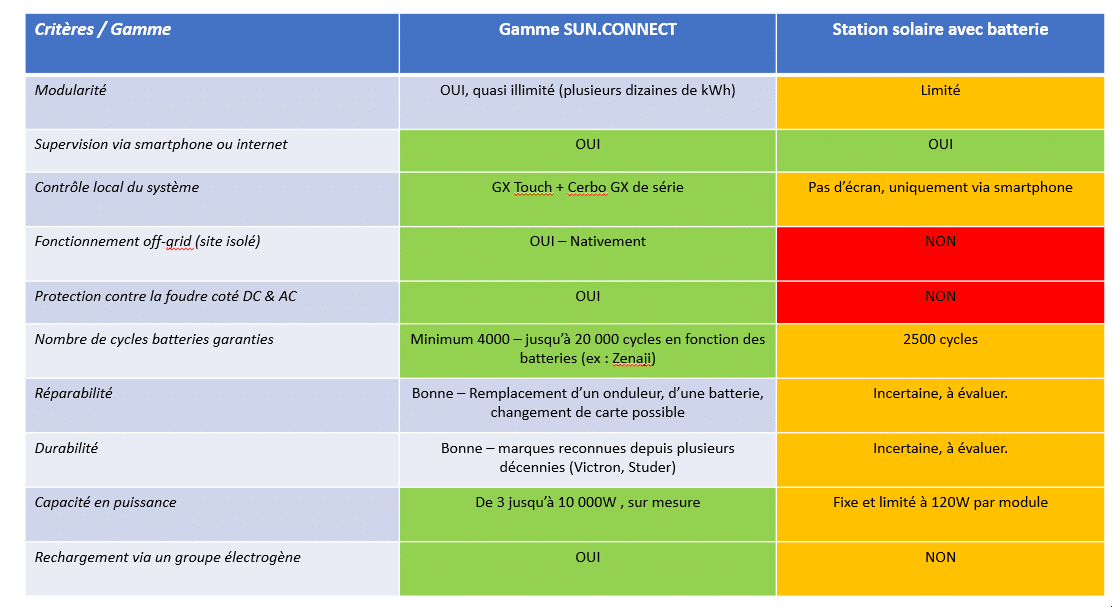Solar station comparison: a (costly) illusion of autonomy?
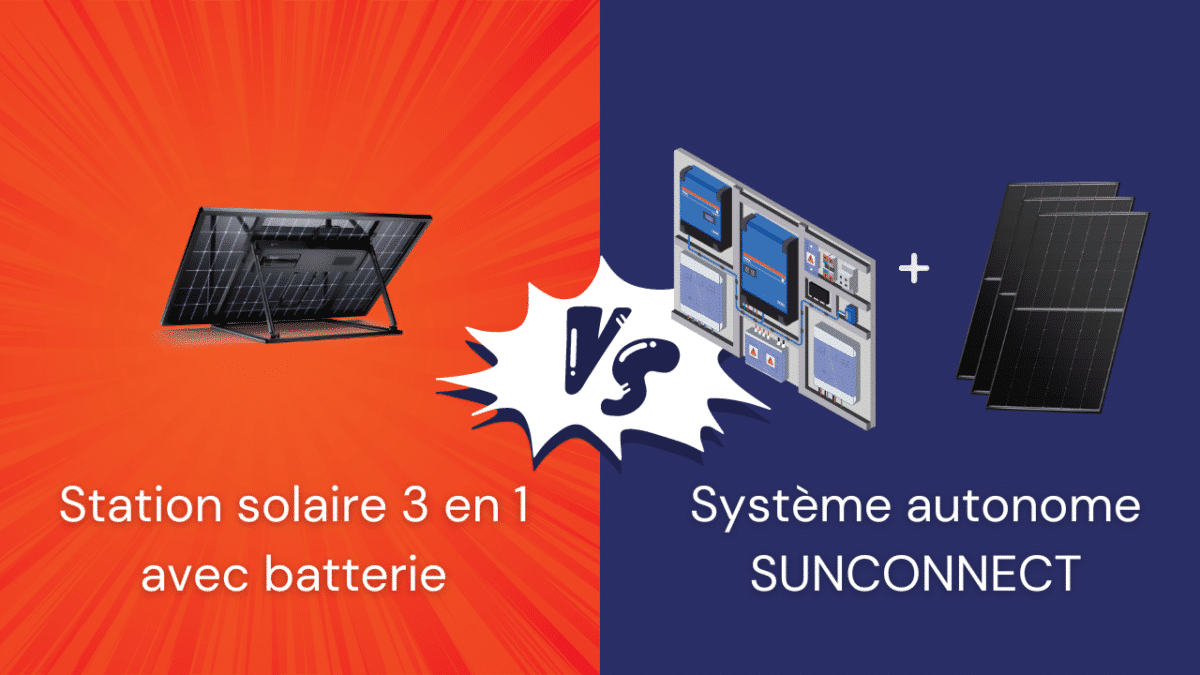
Let’s demystify solar stations a little….
Is the solar station cheaper per kWP?
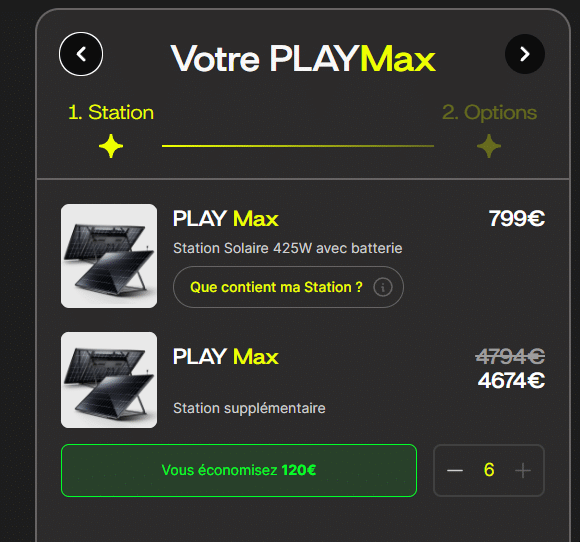

For now, the cost of 7x stations comes to €5473 including tax, WITHOUT batteries. This gives us a cost per kWp of 5473 / 2.98 = 1836 € per kWp, which is quite correct at first glance. However, to what extent is this comparable to a “classic” solution, type kit including a centralized inverter from a major brand (Sungrow for example), similar panels, and ground structures? Such a 3 kWp kit with components equivalent in performance and manufacturing origin (DENIM bi-facial panels, SUNGROW Asian inverter, ground installation structure) displays a price including tax of €3770, or €1250 per kWP. A difference of 48% difficult to justify!
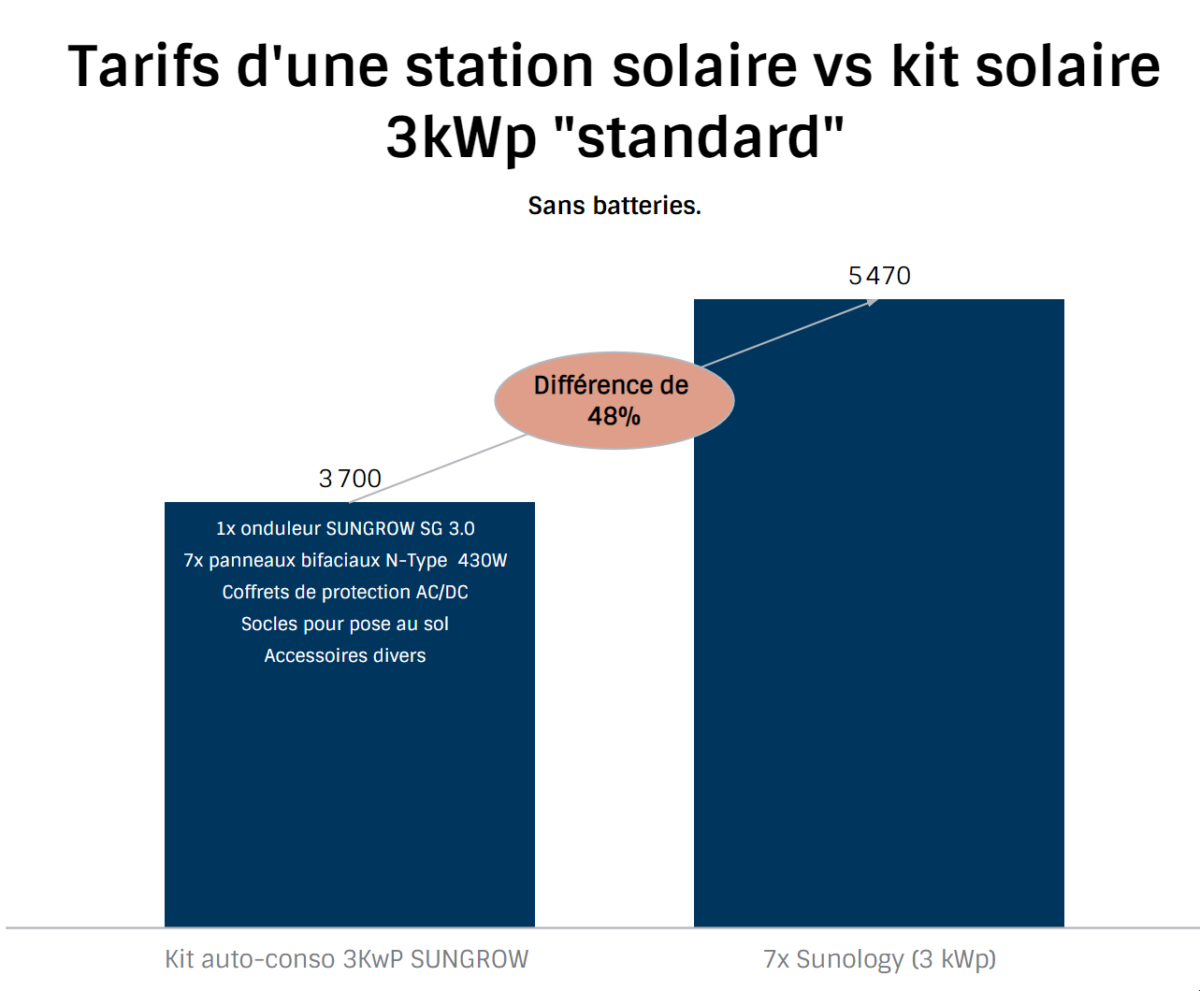
The risk of lightning, a neglected factor:
It therefore clearly appears that the solar station solution is much more expensive, without justification other than a simplification of the implementation of the system. This simplicity sometimes turns out to be deceptive, because a standard solar kit includes protection such as lightning arresters, in particular, which can make the difference between a protected inverter and a blown inverter in the event of lightning. On solar stations, this type of protection is not integrated. Example opposite of a protection box with integrated surge arrester (P1):
SUNOLOGY explains on his site however that the presence of a surge protector is not necessary, given the short distance between the connection socket and the panel (and its microinverter). Very practical, and a saving to boot. Furthermore, the integration of a surge protector would make the very concept of “plug n play” connection impossible. The technical argument is as follows:
The argument raised is the absence of loop induction phenomenon (“induced loop”). This is inaccurate and misleading. Firstly, the cable is not DC (direct current), but AC 230V alternating current, since there is a micro-inverter behind the panel which precisely converts the direct current from the solar panel into alternating current, which will be injected into the socket. Additionally, an induced loop occurs on DC solar cable circuits, not on a single AC cable. (the one coming out of the solar station). In this case therefore, with SUNOLOGY, it is impossible to have induced loops by definition! The argument put forward for the exemption from surge arresters is therefore technically invalid and even dangerously misleading for the user. (especially if we take into account that microinverter manufacturers such as HOYMILES refuse warranty outlets for induced overvoltages!).
Finally, in the absence of a surge protector in your main electrical distribution panel, all the devices connected to it (including your solar station) will be vulnerable to induced overvoltages (= lightning), regardless of its final distance between the (external!) socket and the panel. We are talking here about AC type surge protectors, i.e. capable of protecting equipment such as microinverters, computers, etc. The French photovoltaic UTE standard recommends the use of surge arresters on the AC side, when the lightning density is > 2.5!
Too high a price per kWh per battery module:
Please note that each of these solar stations can accommodate a lithium battery at the back, but they must be ordered individually. The battery pack 0.7 kWh is displayed at €580, which makes us at gross kWh (without deducting a DOD of 90%) 580 / 0.7 = €828 per kWh. This price is already very high, compared to any type of lithium battery on the current market (Pylontech, DEYE). Be careful, however, for its defense, the system has its DC/AC converter, which is not the case on other batteries, it will therefore be necessary to add it for an overall view of the cost.
Calculated by gross kWh, the battery is much more expensive than a DEYE lithium battery, and is equivalent to a TESVOLT battery which will have a lifespan 2 or even 3x longer. Be careful however, here we compare the GROSS price per kWh of each type of battery, knowing that the SUNOLOGY MAX has the AC/DC converter, and not the others (which are bare batteries to which an inverter-charger will have to be added), we will subsequently study the overall cost with the inverter-charger for each system.
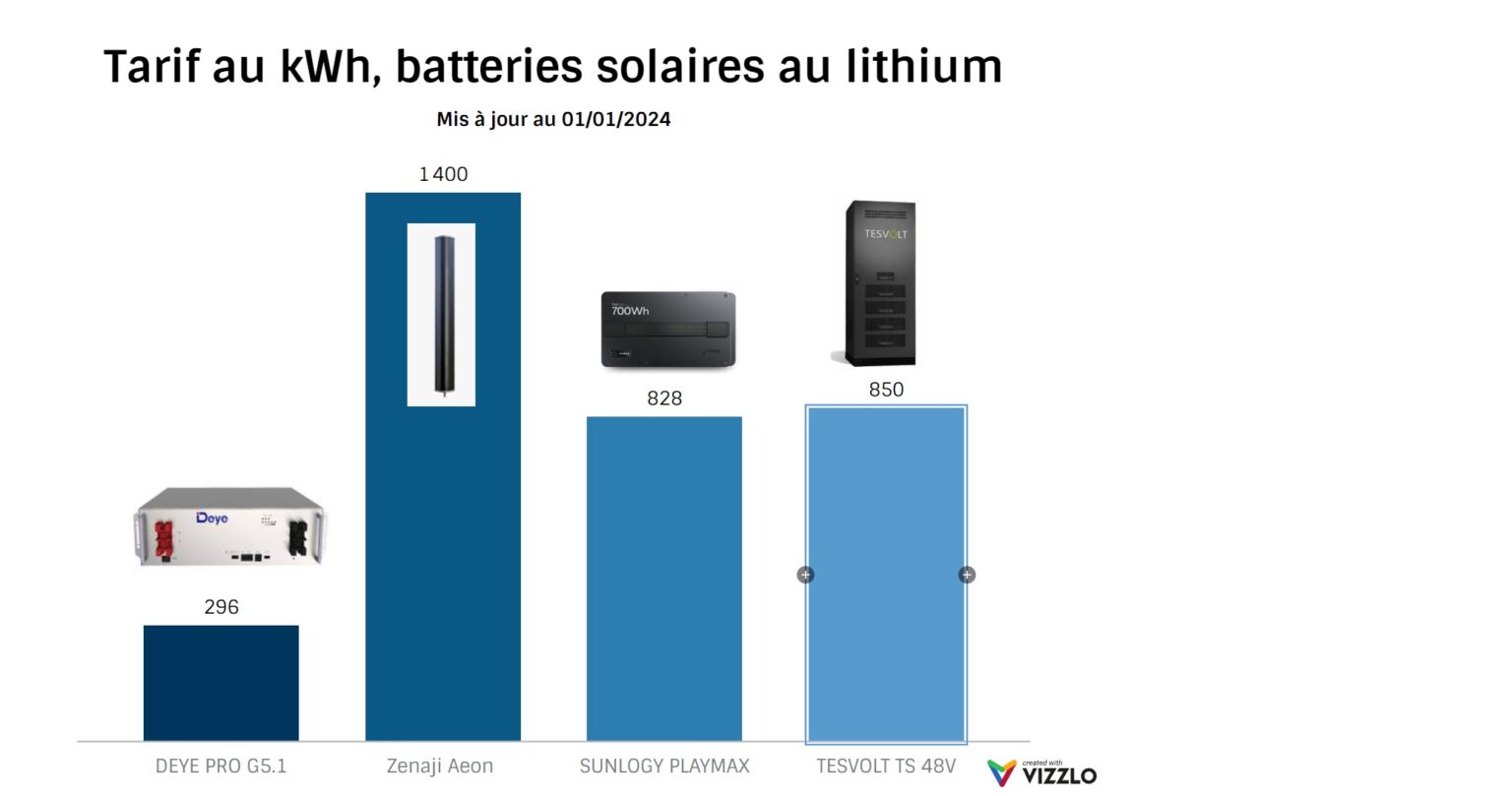
In the end, therefore, the overall cost for a system SUNOLOGY PLAYMAX 3 kWp with 5 kWH of storage, i.e. 7x stations connected in parallele, is broken down as follows:
– 7x SUNOLOGY MAX stations, with a peak power of 2.98 kWp. Each station integrating a HOYMILES brand microinverter,'undisclosed power (350 or 400VA?)
– 7x PLAYMAX batteries with an individual capacity of 0.7 kWh, or a total of 4.97 kWh.
Totaling 9600 € TTC. It is this configuration that we will use as a basis for comparison in the study opposite, and which we will contrast with an autonomous solar system with SUNCONNECT 3000 batteries, composed of the following elements:
- A pre-wired SUNCONNECT 3000 board, with a Victron Multiplus-II 48V/3000VA inverter-charger and its RS 450/100 solar charger
- A Pylontech US5000 battery (or equivalent)
- 7x DENIM bi-glass solar panels, with a total power of 3 KWp + floor mounting supports.
For a total of approximately €9400 including tax.
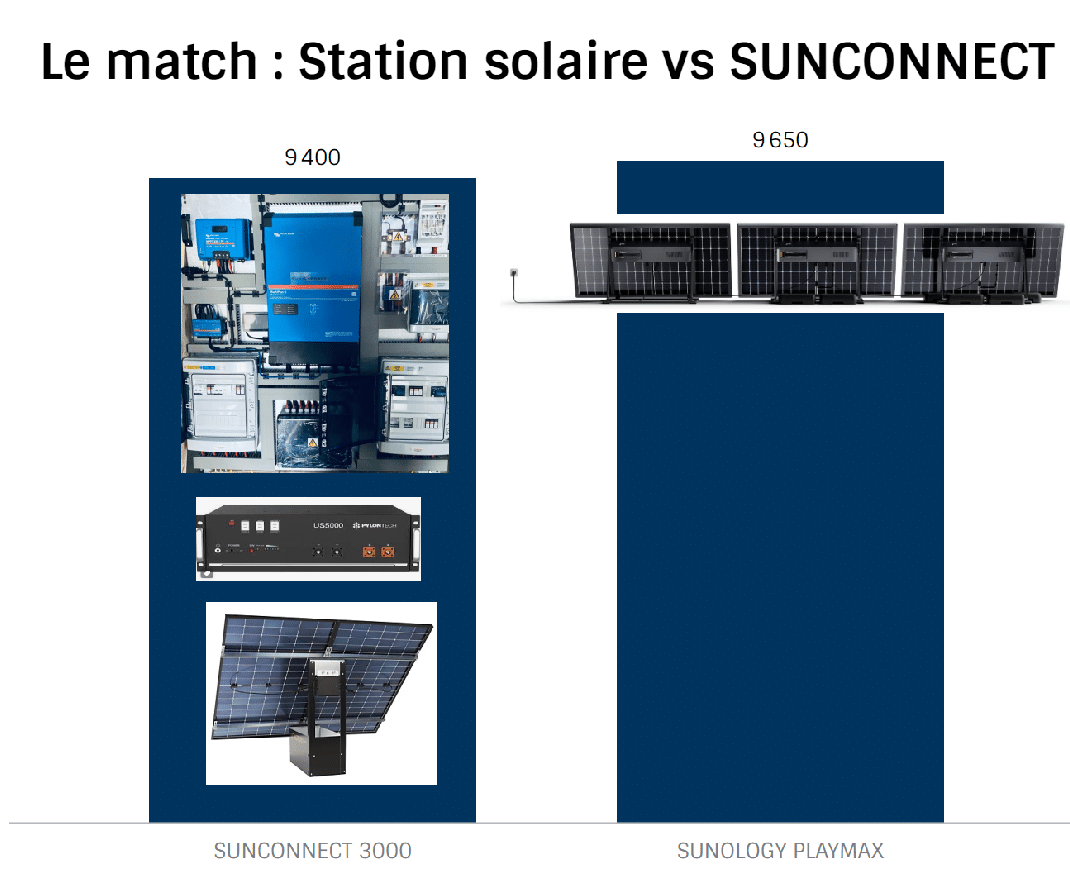
A battery certainly, but restricted and under-exploited!
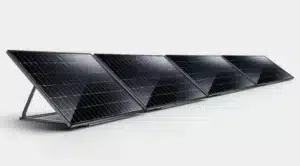
Looking more closely at the technical characteristics of PLAYMAX solar stations with integrated batteries, we note that the latter displays lower performance, compared to the on-board capacity in kWh. Indeed, with 7x PLAYMAX stations accumulating nearly 5 kWh of battery, we struggle to find more than 840W of maximum discharge power, and only 945W of maximum recharge from all the panels. This is little, and corresponds to an underexploitation factor of nearly 6 (in fact, we have potentially 4900VA from the 7x Hoymiles micro inverters, and the batteries are not capable of handling more than 940VA, or 5.44x less.
How can such a low level of performance be explained? Again, the design is the cause:
- The miniaturization of the components behind the panels: to be able to integrate a DC/AC & DC/DC regulator (capable of charging the battery from the solar source) and a converter which will convert the direct current from the battery into 230V towards the home, it is necessary to opt for compact, dissipative components less heat, and therefore having a lower electrical conversion potential. Additionally, the IP65 design of the solar station requires the components to have passive (fanless) cooling. It is therefore impossible to have 400VA of DC/AC conversion in such a small format!
- Maintaining battery life: The more quickly a battery is discharged, the more its lifespan will be impacted (increased internal resistance = accelerated degradation). Limiting the discharge current is a tip to optimize this parameter and limit degradation. By limiting the discharge power of the battery in this way, we obtain a maximum discharge rate of 0.27C. In other words, the calculation is as follows:
135W (maximum charging power from the SUNOLOGY panel to the battery) / 37V (nominal battery voltage) = 3.64A. How to get the discharge speed ratio? We divide 3.64A by the nominal capacity, or 19.2 Ah. We therefore obtain 3.64/19.2 = approximately 0.19C.
Compared to other lithium batteries, the discharge rate is therefore much lower. Indeed, on Pylontech batteries, we have a continuous discharge capacity of 0.5C (so on a 100Ah battery, we can recharge 50A at 48V, or around 2500W, from the panels), or even 1C for several minutes. The advantage? Faster recharging and more efficient mobilization of solar energy, all without impact on lifespan since the batteries are not designed to be exposed to extreme temperatures.
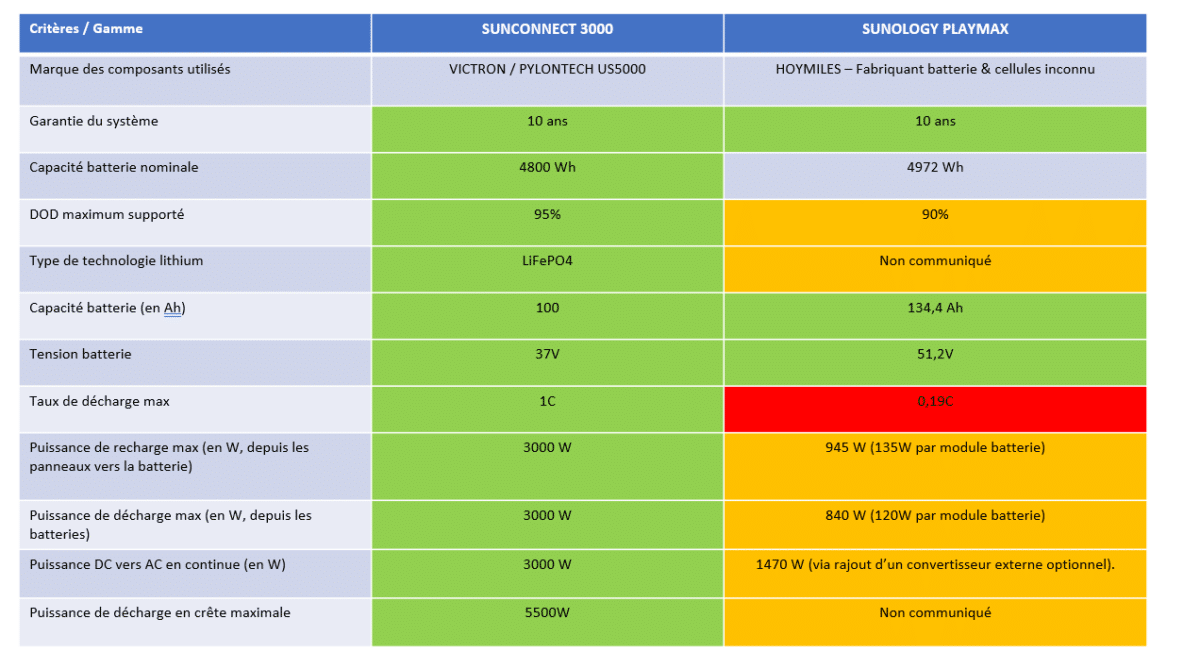
In conclusion, the PLAYMAX battery has the following disadvantages:
- Restriction of the charging power from the solar panels to the battery, at 0.19C, compared to 1C for standard lithium batteries.
- Maximum discharge power from the batteries to consumers very limited, at 945W compared to 3000W for a SUNCONNECT system (each PLAYMAX module can deliver only 135W for a 0.7 kWh battery).
- No overload capability (peak discharge), unlike a SUNCONNECT solution.
- No native possibility of supplying power directly from the battery of AC consumers, unless an external converter is purchased. In which case the maximum power will be 1470W compared to 3000W.
Battery rhymes with autonomy? Not so sure ...
Furthermore, SUNOLOGY stations do not operate in the absence of EDF. In other words, in the event of a power outage, the system:
- Will no longer produce solar energy during the day, the batteries will therefore no longer be recharged.
- Will no longer power the loads to which it is connected, through its 16 or 32A socket towards the house. No “backup” function.
- Will only be usable as a “portable” booster station, via an ad hoc converter to add to the already high amount of the system (€139). For each battery, you will need its AC converter, i.e. 7x €129 = €1000! Clearly unthinkable, particularly in terms of practicality of use (each battery = each converter = non-cumulative power!).
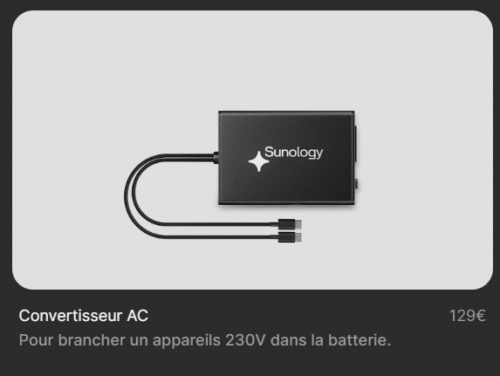
This is obviously a major drawback, since by definition any good solar system with a battery worthy of the name should be able to operate in “autarkic” mode, that is to say in the absence of the EDF network. What's the point of paying for batteries at such a price so as not to be able to use them during possible EDF outages? This is not mentioned anywhere on the SUNOLOGY characteristics, you have to ask a technician to get the unfortunate answer, which is still poorly argued technically. The absence of operation of the solar station without EDF is explained by “network security”. This is false, because self-sufficient solar systems such as SUNCONNECT systems automatically decouple from the EDF network, to be able to recreate a “mini-grid” and restore power to the home. The reality is that the electronics embedded in SUNOLOGY stations are not intrinsically designed to operate in energy self-sufficiency, as we will see through this solar station comparison:
This is the story of a battery behind a solar panel... and Arrhenius' law
In 1889, a Swedish scientist and chemist formulated an equation that we still use to this day to model the degradation of batteries or chemical processes, depending on temperature.

Arrhenius' law has a significant impact on the degradation of a lithium-ion battery, depending on temperatures. According to this law, the speed of chemical reactions increases exponentially with increasing temperature. Particularly in the case of lithium batteries, high temperatures accelerate unwanted chemical reactions inside the cell, such as electrolytic decomposition and the growth of metal deposits. This leads to an increase in the internal resistance of the battery, a decrease in energy storage capacity, and a reduction in the useful life of the battery, at best, and at worst a thermal accident (internal short circuit, formation of dendrites, etc.).
When we know that the battery is located just behind the solar panel, a question arises. Are the temperatures high? Opposite, a graph representing the typical temperature variation behind a solar panel.
When we know that the batteries are located directly behind the solar module, with little insulation, we can easily imagine that during the summer period in particular, temperatures far exceed 30-35°C. This is absolutely critical for the lifespan of the lithium cells found there, recent studies have proven that a Increasing the temperature of lithium batteries to levels close to 60°C accelerated their degradation by a factor of 3.
When we see the assembly process, of high quality, of the solar stations, it is nevertheless difficult to imagine that a simple thermal deflector located under the technical platform which accommodates the components, makes it possible to maintain an optimal thermal amplitude to guarantee operation for 2500 cycles, or 10 years, without failure.

In addition, we note another technical inconsistency. The battery datasheet states that it is IP65 (tropicalized), which is logical and absolutely essential for outdoor operation, but SUNOLOGY also cites un cooling “by convection” (which is impossible if the compartment is waterproof / IP65)

The technical reality is simple. The battery must be IP65, to be able to be placed behind a solar panel and resist corrosion linked to humidity, bad weather, etc. during its lifespan. The argument for “natural convection” without a fan therefore simply amounts to say that it will be cooled, or warmed... depending on the elements and the seasons.
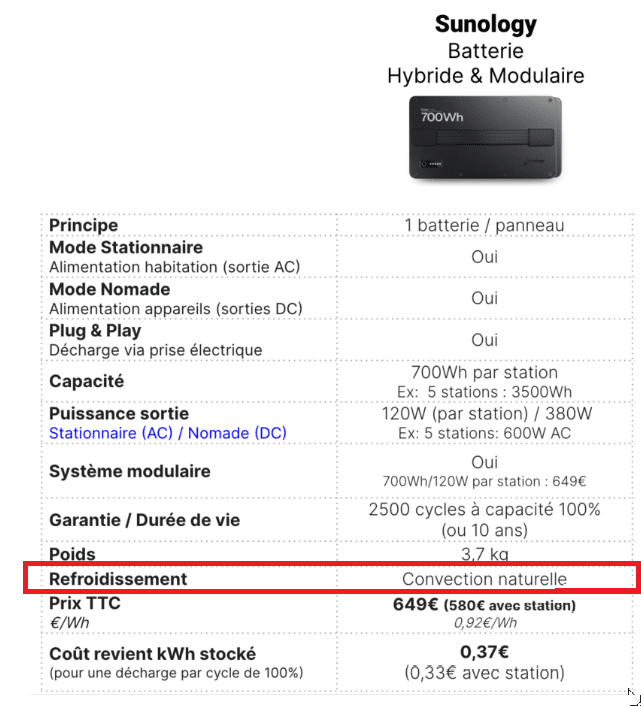
But is it so serious Doctor? After all, the battery is given for 2500 cycles, or 10 years of good and loyal service! It is indeed difficult to accurately model the impact on the lifespan of a lithium battery (it would already be necessary to know the chemistry used in the solar station, which is not specified by the manufacturer, LFP, NMC, LCO?), however, two trends clearly emerge:
- The battery will be degraded much more quickly in a design of this type, than in a closed technical room, at a more constant temperature.
- The risks of thermal failures will be increased due to its use in outdoor conditions, and this in a manner directly correlated to the thermal amplitudes experienced by the battery (example: heatwaves in summer, negative temperatures in winter).
- The battery will likely experience a loss of power at temperatures near 0, which is not specified in the technical data sheets of the solar station. In other words, at -5°C, the battery will not be able to recharge from the solar panels, to preserve its degradation (in fact, charging a lithium-ion battery at negative temperatures can damage it).
Conclusion of the solar station comparison?
Ignoring the (very) clever marketing veneer, the wave of advertising and the attractive appearance of the solar station concept, linked to its ease of implementation (despite obvious security gaps), a slightly in-depth technical analysis reveals avoid technical gaps and opaque features. Due to its high price compared to an autonomous solar solution produced according to the rules of the art, it becomes difficult to see the real added value of this type of product, apart from its relative ease of implementation (which can also be a source of constraint, it should be remembered). Its lack of technical scalability (no backup possible), questionable component durability (notably battery life), and far too incomplete battery charge/discharge capabilities make it a product that is too expensive for its intrinsic technical value.
The only real advantage in our opinion, at the end of this solar station comparison, lies in the aesthetic and practical aspect for its implementation….
